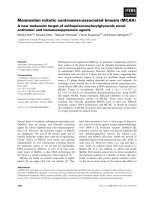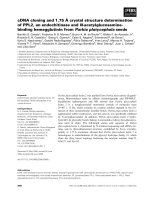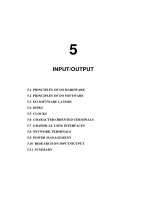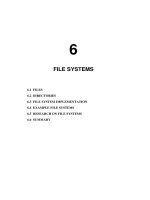A computer system consists of hardware, system programs, and application programs figs 9
Bạn đang xem bản rút gọn của tài liệu. Xem và tải ngay bản đầy đủ của tài liệu tại đây (643.39 KB, 36 trang )
9
SECURITY
9.1 THE SECURITY ENVIRONMENT
9.2 BASICS OF CRYPTOGRAPHY
9.3 USER AUTHENTICATION
9.4 ATTACKS FROM INSIDE THE SYSTEM
9.5 ATTACKS FROM OUTSIDE THE SYSTEM
9.6 PROTECTION MECHANISMS
9.7 TRUSTED SYSTEMS
9.8 RESEARCH ON SECURITY
9.9 SUMMARY
Goal Threat
Data confidentiality Exposure of data
Data integrity Tampering with data
System availability Denial of service
Fig. 9-1. Security goals and threats.
E
K
E
Encryption key
Decryption key
P P
Plaintext in Plaintext out
Encryption
algorithm
D
K
D
Decryption
algorithm
Ciphertext
C = E(P, K
E
)
P = D(C, K
D
)
DecryptionEncryption
Fig. 9-2. Relationship between the plaintext and the ciphertext.
Original
document
Original
document
Document
compressed
to a hash
value
Hash value
run through D
D(Hash)
D(Hash)
Signature
block
Hash
(a)
(b)
Fig. 9-3. (a) Computing a signature block. (b) What the receiver
gets.
LOGIN: ken LOGIN: carol LOGIN: carol
PASSWORD: FooBar INVALID LOGIN NAME PASSWORD: Idunno
SUCCESSFUL LOGIN LOGIN: INVALID LOGIN
LOGIN:
(a) (b) (c)
Fig. 9-4. (a) A successful login. (b) Login rejected after name is
entered. (c) Login rejected after name and password are typed.
LBL> telnet elxsi
ELXSI AT LBL
LOGIN: root
PASSWORD: root
INCORRECT PASSWORD, TRY AGAIN
LOGIN: guest
PASSWORD: guest
INCORRECT PASSWORD, TRY AGAIN
LOGIN: uucp
PASSWORD: uucp
WELCOME TO THE ELXSI COMPUTER AT LBL
Fig. 9-5. How a cracker broke into a U.S. Dept. of Energy com-
puter at LBL.
Bobbie, 4238, e(Dog4238)
Tony, 2918, e(6%%TaeFF2918)
Laura, 6902, e(Shakespeare6902)
Mark, 1694, e(XaB@Bwcz1694)
Deborah, 1092, e(LordByron,1092)
Fig. 9-6. The use of salt to defeat precomputation of encrypted
passwords.
1. Challenge sent to smart card
3. Response sent back
Remote
computer
Smart
card
2. Smart
card
computes
response
Smart
card
reader
Fig. 9-7. Use of a smart card for authentication.
Spring
Pressure plate
Fig. 9-8. A device for measuring finger length.
Login: Login:
(a) (b)
Fig. 9-9. (a) Correct login screen. (b) Phony login screen.
while (TRUE) { while (TRUE) {
printf("login: "); printf("login: ");
get string(name); get string(name);
disable echoing( ); disable echoing( );
printf("password: "); printf("password: ");
get string(password); get string(password);
enable echoing( ); enable echoing( );
v = check validity(name, password);v = check validity(name, password);
if (v) break; if (v || strcmp(name, "zzzzz") == 0) break;
}}
execute shell(name); execute shell(name);
(a) (b)
Fig. 9-10. (a) Normal code. (b) Code with a trap door inserted.
Main’s
local
variables
Program
(a)
0xFFFF
Stack
pointer
Virtual address space
Stack
Main’s
local
variables
Program
Return addr
(b)
SP
Virtual address space
B
Program
(c)
SP
Virtual address space
B
A’s local
variables
Buffer B
Main’s
local
variables
Return addr
A’s local
variables
Fig. 9-11. (a) Situation when the main program is running. (b)
After the procedure A has been called. (c) Buffer overflow shown
in gray.
(a)
First page
(in memory)
Second page
(not in memory)
Page
boundary
A
A
A
A
A
A
(b)
B
A
A
A
A
A
(c)
F
A
A
A
A
A
Fig. 9-12. The TENEX password problem.
#include <sys/types.h> /
*
standard POSIX headers
*
/
#include <sys/stat.h>
#include <dirent.h>
#include <fcntl.h>
#include <unistd.h>
struct stat sbuf; /
*
for lstat call to see if file is sym link
*
/
search(char
*
dir name)
{/
*
recursively search for executables
*
/
DIR
*
dirp; /
*
pointer to an open directory stream
*
/
struct dirent
*
dp; /
*
pointer to a directory entry
*
/
dirp = opendir(dir name); /
*
open this directory
*
/
if (dirp == NULL) return; /
*
dir could not be opened; forget it
*
/
while (TRUE) {
dp = readdir(dirp); /
*
read next directory entry
*
/
if (dp == NULL) { /
*
NULL means we are done
*
/
chdir (" "); /
*
go back to parent directory
*
/
break; /
*
exit loop
*
/
}
if (dp->d name[0] == ’.’) continue; /
*
skip the . and directories
*
/
lstat(dp->d name, &sbuf); /
*
is entry a symbolic link?
*
/
if (S ISLNK(sbuf.st mode)) continue; /
*
skip symbolic links
*
/
if (chdir(dp->d name) == 0) { /
*
if chdir succeeds, it must be a dir
*
/
search("."); /
*
yes, enter and search it
*
/
} else { /
*
no (file), infect it
*
/
if (access(dp->d name,X OK) == 0) /
*
if executable, infect it
*
/
infect(dp->d name);
}
closedir(dirp); /
*
dir processed; close and return
*
/
}
Fig. 9-13. A recursive procedure that finds executable files on a
UNIX system.
(a)
Executable
program
Header
(b)
Executable
program
Header
Virus
(c)
Executable
program
Header
(d)
Header
Virus
Virus
Virus
Virus
Virus
Starting
address
Fig. 9-14. (a) An executable program. (b) With a virus at the front.
(c) With a virus at the end. (d) With a virus spread over free space
within the program.
Operating
system
Virus
Sys call traps
Disk vector
Clock vector
Printer vector
(a)
Operating
system
Virus
Sys call traps
Disk vector
Clock vector
Printer vector
(b)
Operating
system
Virus
Sys call traps
Disk vector
Clock vector
Printer vector
(c)
Fig. 9-15. (a) After the virus has captured all the interrupt and trap
vectors. (b) After the operating system has retaken the printer
interrupt vector. (c) After the virus has noticed the loss of the
printer interrupt vector and recaptured it.
(a)
Executable
program
Header
(b)
Executable
program
Header
(c)
Decompressor
Compressor
Compressed
executable
program
Compressed
executable
program
Header
(d)
Decryptor
Header
Encryptor
Compressor
Encrypted
Virus
Decompressor
Compressed
executable
program
Encryptor
Compressor
Encrypted
Virus
Decompressor
(e)
Header
File is longer
Virus
Original size
Virus
Original size Original size
Encrypted
Key
Decryptor
Key
Unused
Fig. 9-16. (a) A program. (b) An infected program.
(c) A compressed infected program. (d) An encrypted virus. (e) A
compressed virus with encrypted compression code.
MOV A,R1 MOV A,R1 MOV A,R1 MOV A,R1 MOV A,R1
ADD B,R1 NOP ADD #0,R1 OR R1,R1 TST R1
ADD C,R1 ADD B,R1 ADD B,R1 ADD B,R1 ADD C,R1
SUB #4,R1 NOP OR R1,R1 MOV R1,R5 MOV R1,R5
MOV R1,X ADD C,R1 ADD C,R1 ADD C,R1 ADD B,R1
NOP SHL #0,R1 SHL R1,0 CMP R2,R5
SUB #4,R1 SUB #4,R1 SUB #4,R1 SUB #4,R1
NOP JMP .+1 ADD R5,R5 JMP .+1
MOV R1,X MOV R1,X MOV R1,X MOV R1,X
MOV R5,Y MOV R5,Y
(a) (b) (c) (d) (e)
Fig. 9-17. Examples of a polymorphic virus.
(a) (b)
256
224
192
160
128
96
64
32
0
Ref. Mon.
Code 1
Data 1
Code 2
Data 2
Reference
monitor for
checking
system
Applet 2
Applet 1
MOV R1, S1
SHR #24, S1
CMP S1, S2
TRAPNE
JMP (R1)
Virual
address
in MB
Fig. 9-18. (a) Memory divided into 16-MB sandboxes. (b) One
way of checking an instruction for validity.
Untrusted applet
Trusted applet
Web browser
Sandbox
Interpreter
Virtual address space
0xFFFFFFFF
0
Fig. 9-19. Applets can be interpreted by a Web browser.
Software vendor
Signature generation
H = hash(Applet)
Signature = encrypt(H)
Applet
Signature
User
Applet
Signature
Internet
Signature verification
H1 = hash(Applet)
H2 = decrypt(Signature)
Accept Applet if H1 = H2
Fig. 9-20. How code signing works.
URL Signer Object Action
www.taxprep.com TaxPrep /usr/susan/1040.xls Read
*
/usr/tmp/
*
Read, Write
www.microsoft.com Microsoft /usr/susan/Office/– Read, Write, Delete
Fig. 9-21. Some examples of protection that can be specified with
JDK 1.2.
Domain 1 Domain 2 Domain 3
File1[R]
File2[RW]
File3[R]
File4[RWX]
File5[RW]
Printer1[W]
File6[RWX]
Plotter2[W]
Fig. 9-22. Three protection domains.
Printer1 Plotter2
Domain
1
2
3
File1 File2 File3 File4 File5 File6
Object
Read
Read
Read
Write
Read
Write
Read
Write
Execute
Read
Write
Execute
Write
Write Write
Fig. 9-23. A protection matrix.
Object
Domain2 Domain3Domain1
Enter
Printer1 Plotter2
Domain
1
2
3
File1 File2 File3 File4 File5 File6
Read
Read
Read
Write
Read
Write
Read
Write
Execute
Read
Write
Execute
Write
Write Write
Fig. 9-24. A protection matrix with domains as objects.









